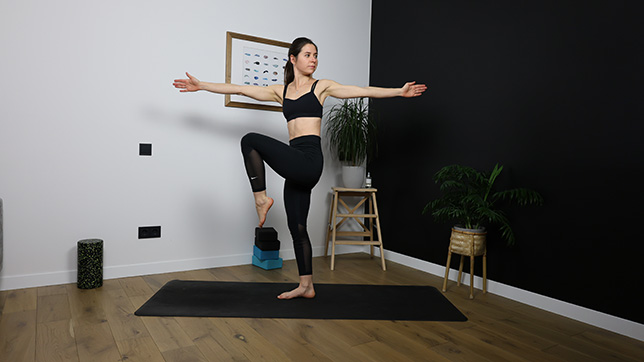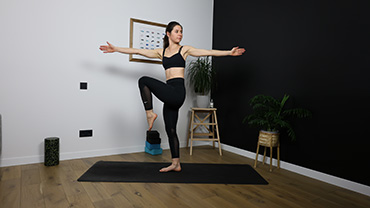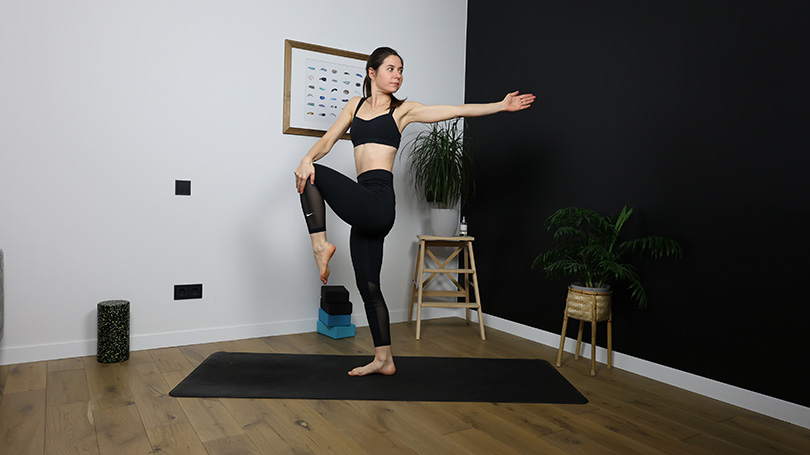One Legged Revolved Mountain Pose - Eka Pada Parivrtta Tadasana

Contents
One Legged Revolved Mountain Pose also known as Twisting Mountain Pose or Eka Pada Parivrtta Tadasana, is a standing yoga posture that involves twisting the torso while balancing on one leg. This pose is an intermediate to advanced level pose that requires strength, balance, and flexibility.
One-Legged Revolved Mountain Pose offers a variety of benefits for the body and mind. It stretches and strengthens the legs, hips, spine, and shoulders, while also improving balance, focus, and concentration. It can also help to improve digestion and detoxify the body.
Pose Detail
- Difficulty: Advanced, Intermediate
- By Type: Balancing Yoga Poses, Flexibility Yoga Poses, Strengthening Yoga Poses
- Body Position: Standing Yoga Poses, Twist Yoga Poses
- By Benefit: Yoga Poses For Digestion, Yoga Poses For Stress Relief
Step-by-Step Instructions
Benefits and Contraindications
Improves balance and stability
Stretches and strengthens the hips, hamstrings, and spine
Helps to detoxify the body
Strengthens the legs, ankles, and core muscles
Massages the internal organs, improving digestion and metabolism
Calms the mind and improves focus and concentration
High or low blood pressure
Knee or ankle injuries
Neck or spinal injuries
Pregnancy
Photo poses in different angles

Modifications and Props for Beginners
- If you find it challenging to balance in this pose, you can practice with your back against a wall or use a chair or block for support. This can help you maintain your balance while still getting the benefits of the pose.
- If you find it challenging to place your foot on your thigh, you can modify the pose by placing your foot on your calf instead.
- You can also use a strap around your raised foot to help you maintain your balance and extend your leg.
Useful Tips
- As you twist, keep your spine long and your chest lifted. Avoid collapsing your chest or rounding your shoulders.
- Keep your gaze straight ahead or up, rather than looking down at the ground.
- To help maintain your balance and deepen the stretch, engage your leg muscles and draw your navel towards your spine.
- Keep your standing leg strong and engaged throughout the pose.
- Take slow, deep breaths to help you maintain focus and balance.
- Move slowly and mindfully into the pose, avoiding any sudden or jerky movements.
Variation
If it is easy for you to hold this pose, you can lower your right hand on your knee. In this pose, more emphasis will be placed on balancing.

Frequently Asked Questions
This pose targets the legs, hips, core, and spine muscles.
It can be challenging for beginners, but with modifications and the guidance of a qualified yoga teacher, it can be safe and beneficial.
Aim to hold the pose for 5-10 breaths on each side. As you become more comfortable with the pose, you can gradually increase the duration.
It is recommended to avoid this pose during pregnancy, as it can be challenging to balance and can put pressure on the abdomen.
You can use a wall or chair for support, place your foot on your calf instead of your thigh, or use props like blocks or straps to help you maintain your balance and extend your leg.
Yes, the twisting aspect of the pose can help massage the internal organs, improving digestion and metabolism.
Yes, the pose can help calm the mind and improve focus and concentration, making it a great way to reduce stress and anxiety.
Variations
- One-Legged Mountain Pose
- One Legged Revolved Mountain Pose With A Chair
- One Legged Revolved Mountain Pose Near The Wall